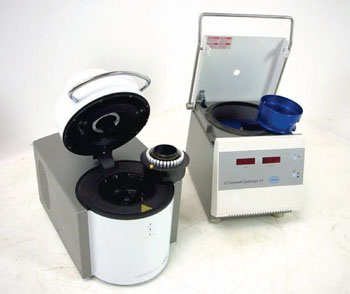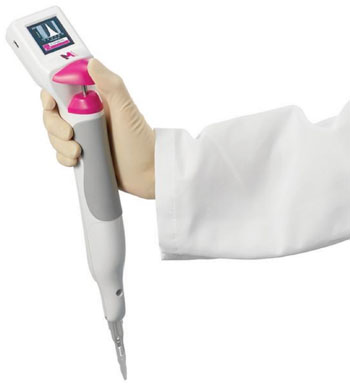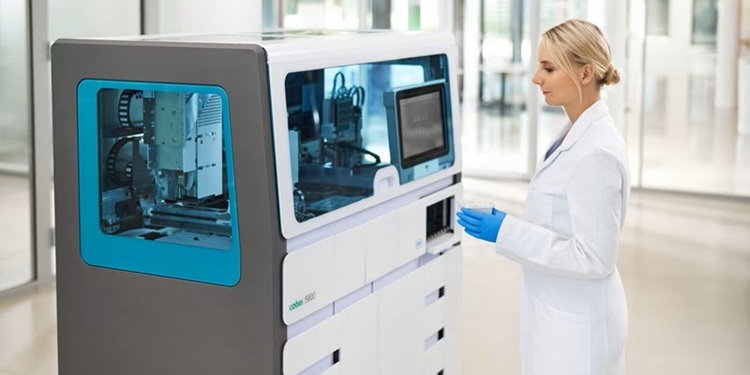Genotyping Performed by FRET-PCR Without DNA Extraction
|
By LabMedica International staff writers Posted on 07 Jul 2014 |

Image: The LightCycler 2.0 real-time polymerase chain reaction analyzer and centrifuge (Photo courtesy of Roche).”

Image: The Scepter 2.0 Automated Cell Counter (Photo courtesy of Merck Millipore).
Blood samples are extensively used for the molecular diagnosis of many hematological diseases using a variety of techniques, based on the amplification of nucleic acids.
Current methods for polymerase chain reaction (PCR) use purified genomic DNA, mostly isolated from total peripheral blood cells or white blood cells (WBC), which can be improved by a real-time fluorescence resonance energy transfer-based method for genotyping directly from blood cells.
Hematologists at the Hospital Universitari Son Espases (Palma de Mallorca, Spain) studied peripheral blood from 34 patients collected into tubes containing ethylenediaminetetraacetic acid (EDTA). Among the samples, they included a mixture of mutant alleles for patients suffering from thrombosis or hereditary hemochromatosis. Red blood cells (RBCs) were lysed and white blood cells (WBCs) isolated. A real-time PCR was then performed followed by a melting curve analysis for different genes including methylenetetrahydrofolate reductase (MTHFR), hemochromatosis (HFE), coagulation factor V Leiden (F5), prothrombin factor two (F2) and coagulation factor XII (F12).
The real time PCR was performed on the LightCycler 2.0 Instrument (Roche Diagnostics Corporation, Indianapolis, IN, USA). In order to standardize the samples for the real-time PCR reaction, cells were counted in a Scepter 2.0 Automated Cell Counter (Merck Millipore, Billerica, MA, USA) and adjusted to 5×106 cells/mL. After testing 34 samples comparing the real-time crossing point (CP) values between 5×106 WBC/mL and 20 ng/µL of purified DNA, the results for F5 Leiden were as follows: CP mean value for WBC was 29.26 ± 0.57 versus purified DNA 24.79 ± 0.56. There was an observed delay of about four cycles when PCR was performed from WBC instead of DNA.
The authors concluded that their protocol obviates the DNA purification stage, thereby saving time and resources. Furthermore, since the manipulation performed on the sample is minimal, it may decrease the risk of contamination. As they reported the results from a variety of genes, they contend that their protocol will be suitable for the genotyping of almost any inherited polymorphism. The study was published on June 25, 2014, in the Journal of Blood Medicine.
Related Links:
Hospital Universitari Son Espases
Roche Diagnostics Corporation
Merck Millipore
Current methods for polymerase chain reaction (PCR) use purified genomic DNA, mostly isolated from total peripheral blood cells or white blood cells (WBC), which can be improved by a real-time fluorescence resonance energy transfer-based method for genotyping directly from blood cells.
Hematologists at the Hospital Universitari Son Espases (Palma de Mallorca, Spain) studied peripheral blood from 34 patients collected into tubes containing ethylenediaminetetraacetic acid (EDTA). Among the samples, they included a mixture of mutant alleles for patients suffering from thrombosis or hereditary hemochromatosis. Red blood cells (RBCs) were lysed and white blood cells (WBCs) isolated. A real-time PCR was then performed followed by a melting curve analysis for different genes including methylenetetrahydrofolate reductase (MTHFR), hemochromatosis (HFE), coagulation factor V Leiden (F5), prothrombin factor two (F2) and coagulation factor XII (F12).
The real time PCR was performed on the LightCycler 2.0 Instrument (Roche Diagnostics Corporation, Indianapolis, IN, USA). In order to standardize the samples for the real-time PCR reaction, cells were counted in a Scepter 2.0 Automated Cell Counter (Merck Millipore, Billerica, MA, USA) and adjusted to 5×106 cells/mL. After testing 34 samples comparing the real-time crossing point (CP) values between 5×106 WBC/mL and 20 ng/µL of purified DNA, the results for F5 Leiden were as follows: CP mean value for WBC was 29.26 ± 0.57 versus purified DNA 24.79 ± 0.56. There was an observed delay of about four cycles when PCR was performed from WBC instead of DNA.
The authors concluded that their protocol obviates the DNA purification stage, thereby saving time and resources. Furthermore, since the manipulation performed on the sample is minimal, it may decrease the risk of contamination. As they reported the results from a variety of genes, they contend that their protocol will be suitable for the genotyping of almost any inherited polymorphism. The study was published on June 25, 2014, in the Journal of Blood Medicine.
Related Links:
Hospital Universitari Son Espases
Roche Diagnostics Corporation
Merck Millipore
Latest Molecular Diagnostics News
- Blood Test to Enable Earlier and Simpler Detection of Liver Fibrosis
- Genetic Marker to Help Children with T-Cell Leukemia Avoid Unnecessary Chemotherapy
- Four-Gene Blood Test Rules Out Bacterial Lung Infection
- New PCR Test Improves Diagnostic Accuracy of Bacterial Vaginosis and Candida Vaginitis
- New Serum Marker-Editing Strategy to Improve Diagnosis of Neurological Diseases
- World’s First Genetic Type 1 Diabetes Risk Test Enables Early Detection
- Blood Test to Help Low-Risk Gastric Cancer Patients Avoid Unnecessary Surgery
- First-Of-Its-Kind Automated System Speeds Myeloma Diagnosis
- Blood Protein Profiles Predict Mortality Risk for Earlier Medical Intervention
- First Of Its Kind Blood Test Detects Gastric Cancer in Asymptomatic Patients
- Portable Molecular Test Detects STIs at POC in 15 Minutes
- Benchtop Analyzer Runs Chemistries, Immunoassays and Hematology in Single Device
- POC Bordetella Test Delivers PCR-Accurate Results in 15 Minutes
- Pinprick Blood Test Could Detect Disease 10 Years Before Symptoms Appear
- Refined C-Reactive Protein Cutoffs Help Assess Sepsis Risk in Preterm Babies
- Blood Test Accurately Detects Brain Amyloid Pathology in Symptomatic Patients
Channels
Clinical Chemistry
view channel
Chemical Imaging Probe Could Track and Treat Prostate Cancer
Prostate cancer remains a leading cause of illness and death among men, with many patients eventually developing resistance to standard hormone-blocking therapies. These drugs often lose effectiveness... Read more
Mismatch Between Two Common Kidney Function Tests Indicates Serious Health Problems
Creatinine has long been the standard for measuring kidney filtration, while cystatin C — a protein produced by all human cells — has been recommended as a complementary marker because it is influenced... Read moreMolecular Diagnostics
view channel
Blood Test to Enable Earlier and Simpler Detection of Liver Fibrosis
Persistent liver damage caused by alcohol misuse or viral infections can trigger liver fibrosis, a condition in which healthy tissue is gradually replaced by collagen fibers. Even after successful treatment... Read more
Genetic Marker to Help Children with T-Cell Leukemia Avoid Unnecessary Chemotherapy
About 400 children in the UK are diagnosed with acute lymphoblastic leukemia (ALL) each year, with roughly 15% presenting with a more aggressive T-ALL subtype. While the standard approach is a four-week... Read more
Four-Gene Blood Test Rules Out Bacterial Lung Infection
Lower respiratory tract infections (LRTIs) are among the most common reasons for antibiotic prescriptions, yet distinguishing bacterial infections from viral ones remains notoriously difficult.... Read more
New PCR Test Improves Diagnostic Accuracy of Bacterial Vaginosis and Candida Vaginitis
Bacterial vaginosis (BV) impacts approximately 25% of women of reproductive age, while up to 75% of women experience candida vaginitis (CV) at least once in their lifetime. Vaginal symptoms are one of... Read moreImmunology
view channel
New Test Distinguishes Vaccine-Induced False Positives from Active HIV Infection
Since HIV was identified in 1983, more than 91 million people have contracted the virus, and over 44 million have died from related causes. Today, nearly 40 million individuals worldwide live with HIV-1,... Read more
Gene Signature Test Predicts Response to Key Breast Cancer Treatment
DK4/6 inhibitors paired with hormone therapy have become a cornerstone treatment for advanced HR+/HER2– breast cancer, slowing tumor growth by blocking key proteins that drive cell division.... Read more
Chip Captures Cancer Cells from Blood to Help Select Right Breast Cancer Treatment
Ductal carcinoma in situ (DCIS) accounts for about a quarter of all breast cancer cases and generally carries a good prognosis. This non-invasive form of the disease may or may not become life-threatening.... Read moreMicrobiology
view channel
Rapid Diagnostic Test Matches Gold Standard for Sepsis Detection
Sepsis kills 11 million people worldwide every year and generates massive healthcare costs. In the USA and Europe alone, sepsis accounts for USD 100 billion in annual hospitalization expenses.... Read moreRapid POC Tuberculosis Test Provides Results Within 15 Minutes
Tuberculosis remains one of the world’s deadliest infectious diseases, and reducing new cases depends on identifying individuals with latent infection before it progresses. Current diagnostic tools often... Read more
Rapid Assay Identifies Bloodstream Infection Pathogens Directly from Patient Samples
Bloodstream infections in sepsis progress quickly and demand rapid, precise diagnosis. Current blood-culture methods often take one to five days to identify the pathogen, leaving clinicians to treat blindly... Read morePathology
view channel
Tunable Cell-Sorting Device Holds Potential for Multiple Biomedical Applications
Isolating rare cancer cells from blood is essential for diagnosing metastasis and guiding treatment decisions, but remains technically challenging. Many existing techniques struggle to balance accuracy,... Read moreAI Tool Outperforms Doctors in Spotting Blood Cell Abnormalities
Diagnosing blood disorders depends on recognizing subtle abnormalities in cell size, shape, and structure, yet this process is slow, subjective, and requires years of expert training. Even specialists... Read moreTechnology
view channel
Artificial Intelligence Model Could Accelerate Rare Disease Diagnosis
Identifying which genetic variants actually cause disease remains one of the biggest challenges in genomic medicine. Each person carries tens of thousands of DNA changes, yet only a few meaningfully alter... Read more
AI Saliva Sensor Enables Early Detection of Head and Neck Cancer
Early detection of head and neck cancer remains difficult because the disease produces few or no symptoms in its earliest stages, and lesions often lie deep within the head or neck, where biopsy or endoscopy... Read moreIndustry
view channel
Abbott Acquires Cancer-Screening Company Exact Sciences
Abbott (Abbott Park, IL, USA) has entered into a definitive agreement to acquire Exact Sciences (Madison, WI, USA), enabling it to enter and lead in fast-growing cancer diagnostics segments.... Read more





















